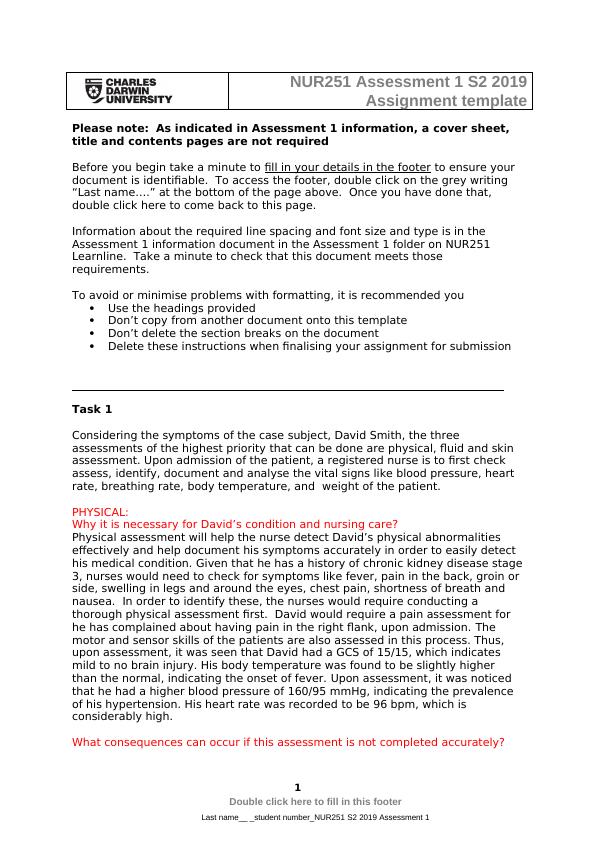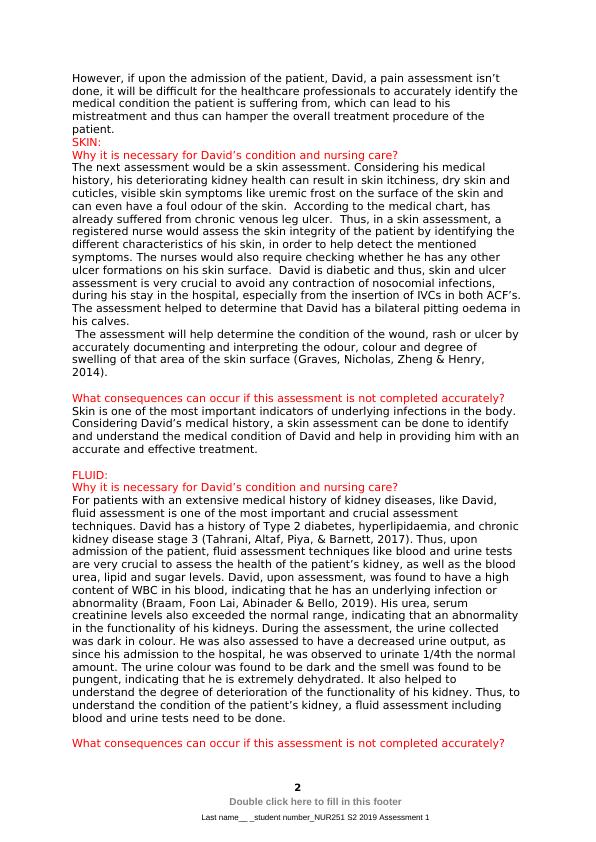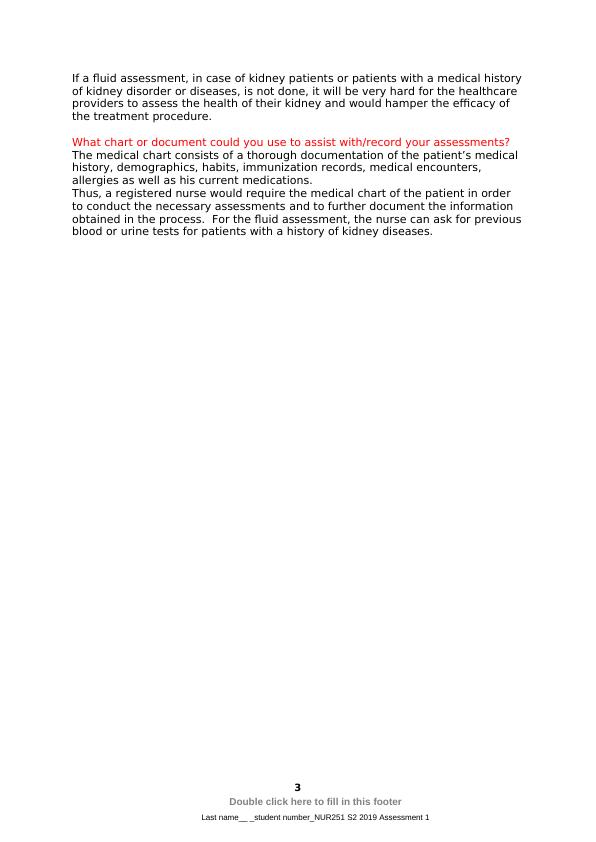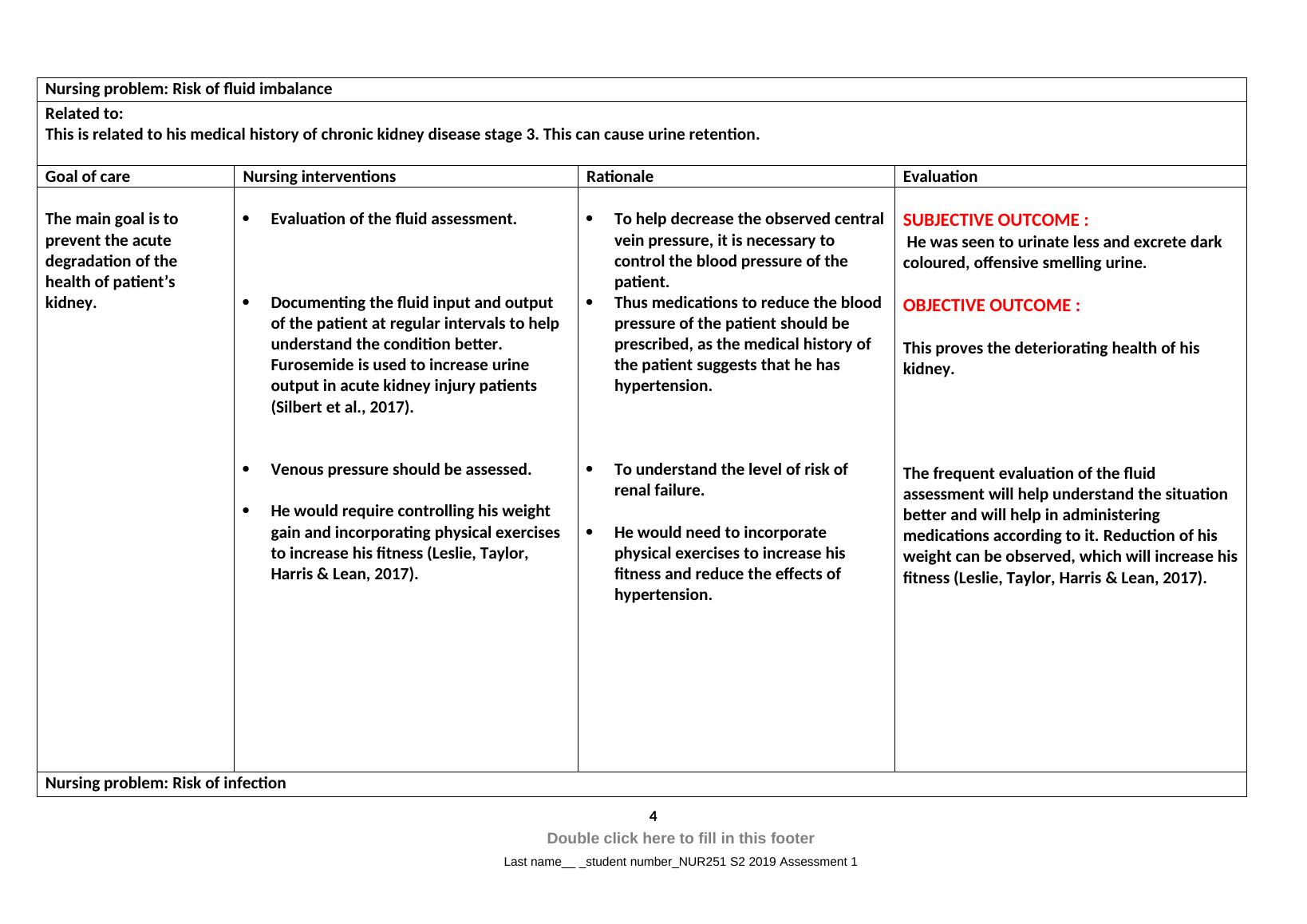Physical Abnormalities and assessment 2022
NUR251 Assessment 1 S2 2019 Assignment template
Added on 2022-10-04
About This Document
Hello, this is my nursing third year medical surgical assignment .total word count is 2000 included intext citation and heading ,minimum 10 peer reviwed Australian Nursing journal Artical with in 2009-2019 .ONLY AUSTRALIAN NURSING JOURNAL ARTICLE .you can use only one tesk book which is (Medical surgical book by lemone burke and one medicine book (Harvard's Nursing Guide to Drugs by tiziani ).referenceing is APA 6th edition with doi . There are four task in assignment and you have to do this task in provided templet with I have attached .IN task one you have to find the 3 nursing assessment I want you do write about ,Physical assessment ,fluid assessment and skin assessment .
Physical Abnormalities and assessment 2022
NUR251 Assessment 1 S2 2019 Assignment template
Added on 2022-10-04
Assignment template
Please note: As indicated in Assessment 1 information, a cover sheet,
title and contents pages are not required
Before you begin take a minute to fill in your details in the footer to ensure your
document is identifiable. To access the footer, double click on the grey writing
“Last name....” at the bottom of the page above. Once you have done that,
double click here to come back to this page.
Information about the required line spacing and font size and type is in the
Assessment 1 information document in the Assessment 1 folder on NUR251
Learnline. Take a minute to check that this document meets those
requirements.
To avoid or minimise problems with formatting, it is recommended you
Use the headings provided
Don’t copy from another document onto this template
Don’t delete the section breaks on the document
Delete these instructions when finalising your assignment for submission
Task 1
Considering the symptoms of the case subject, David Smith, the three
assessments of the highest priority that can be done are physical, fluid and skin
assessment. Upon admission of the patient, a registered nurse is to first check
assess, identify, document and analyse the vital signs like blood pressure, heart
rate, breathing rate, body temperature, and weight of the patient.
PHYSICAL:
Why it is necessary for David’s condition and nursing care?
Physical assessment will help the nurse detect David’s physical abnormalities
effectively and help document his symptoms accurately in order to easily detect
his medical condition. Given that he has a history of chronic kidney disease stage
3, nurses would need to check for symptoms like fever, pain in the back, groin or
side, swelling in legs and around the eyes, chest pain, shortness of breath and
nausea. In order to identify these, the nurses would require conducting a
thorough physical assessment first. David would require a pain assessment for
he has complained about having pain in the right flank, upon admission. The
motor and sensor skills of the patients are also assessed in this process. Thus,
upon assessment, it was seen that David had a GCS of 15/15, which indicates
mild to no brain injury. His body temperature was found to be slightly higher
than the normal, indicating the onset of fever. Upon assessment, it was noticed
that he had a higher blood pressure of 160/95 mmHg, indicating the prevalence
of his hypertension. His heart rate was recorded to be 96 bpm, which is
considerably high.
What consequences can occur if this assessment is not completed accurately?
1
Double click here to fill in this footer
Last name__ _student number_NUR251 S2 2019 Assessment 1

done, it will be difficult for the healthcare professionals to accurately identify the
medical condition the patient is suffering from, which can lead to his
mistreatment and thus can hamper the overall treatment procedure of the
patient.
SKIN:
Why it is necessary for David’s condition and nursing care?
The next assessment would be a skin assessment. Considering his medical
history, his deteriorating kidney health can result in skin itchiness, dry skin and
cuticles, visible skin symptoms like uremic frost on the surface of the skin and
can even have a foul odour of the skin. According to the medical chart, has
already suffered from chronic venous leg ulcer. Thus, in a skin assessment, a
registered nurse would assess the skin integrity of the patient by identifying the
different characteristics of his skin, in order to help detect the mentioned
symptoms. The nurses would also require checking whether he has any other
ulcer formations on his skin surface. David is diabetic and thus, skin and ulcer
assessment is very crucial to avoid any contraction of nosocomial infections,
during his stay in the hospital, especially from the insertion of IVCs in both ACF’s.
The assessment helped to determine that David has a bilateral pitting oedema in
his calves.
The assessment will help determine the condition of the wound, rash or ulcer by
accurately documenting and interpreting the odour, colour and degree of
swelling of that area of the skin surface (Graves, Nicholas, Zheng & Henry,
2014).
What consequences can occur if this assessment is not completed accurately?
Skin is one of the most important indicators of underlying infections in the body.
Considering David’s medical history, a skin assessment can be done to identify
and understand the medical condition of David and help in providing him with an
accurate and effective treatment.
FLUID:
Why it is necessary for David’s condition and nursing care?
For patients with an extensive medical history of kidney diseases, like David,
fluid assessment is one of the most important and crucial assessment
techniques. David has a history of Type 2 diabetes, hyperlipidaemia, and chronic
kidney disease stage 3 (Tahrani, Altaf, Piya, & Barnett, 2017). Thus, upon
admission of the patient, fluid assessment techniques like blood and urine tests
are very crucial to assess the health of the patient’s kidney, as well as the blood
urea, lipid and sugar levels. David, upon assessment, was found to have a high
content of WBC in his blood, indicating that he has an underlying infection or
abnormality (Braam, Foon Lai, Abinader & Bello, 2019). His urea, serum
creatinine levels also exceeded the normal range, indicating that an abnormality
in the functionality of his kidneys. During the assessment, the urine collected
was dark in colour. He was also assessed to have a decreased urine output, as
since his admission to the hospital, he was observed to urinate 1/4th the normal
amount. The urine colour was found to be dark and the smell was found to be
pungent, indicating that he is extremely dehydrated. It also helped to
understand the degree of deterioration of the functionality of his kidney. Thus, to
understand the condition of the patient’s kidney, a fluid assessment including
blood and urine tests need to be done.
What consequences can occur if this assessment is not completed accurately?
2
Double click here to fill in this footer
Last name__ _student number_NUR251 S2 2019 Assessment 1

of kidney disorder or diseases, is not done, it will be very hard for the healthcare
providers to assess the health of their kidney and would hamper the efficacy of
the treatment procedure.
What chart or document could you use to assist with/record your assessments?
The medical chart consists of a thorough documentation of the patient’s medical
history, demographics, habits, immunization records, medical encounters,
allergies as well as his current medications.
Thus, a registered nurse would require the medical chart of the patient in order
to conduct the necessary assessments and to further document the information
obtained in the process. For the fluid assessment, the nurse can ask for previous
blood or urine tests for patients with a history of kidney diseases.
3
Double click here to fill in this footer
Last name__ _student number_NUR251 S2 2019 Assessment 1

Nursing Care Plan: David Smith
Nursing problem: Acute Pain
Related to:
Upon assessment it was revealed that patient experienced pain in the right flank, which is a very common symptom of
kidney infection or pyelonephritis.
This usually occurs due to renal obstruction. This can also be due to his constipation.
Goal of care Nursing interventions Rationale Evaluation
The main goal for
this condition
would be to
decrease the pain
level in order to
lessen the
discomfort of the
patient and
reduce his anxiety
and agitation
(Rosenbaum,
Tiedemann,
Stanton, Parker,
Waterreus, Curtis
& Ward, 2016).
The nurses are to assess the
pain experienced by the
patient, document the
concerns of the patient and
conduct a pain assessment to
accurately understand the
intensity of the pain (Mitchell,
Say, Wells, Wilson, Cloete &
Matheson, 2014).
Using a catheter to release
the urine accumulated, in
order to relive the patient
from his pain.
Encourage the patient to
communicate his concerns.
To accurately evaluate the
degree of discomfort by
conduction of a pain
assessment of the patient.
Based on the pain scale
score obtained during the
assessment, nursing
interventions are to be
planned. Thus to effectively
manage the pain, the
patient is given mild pain
killers.
The pain observed in the
right flank might be due to
the urine retention in the
renal tracts. Thus, a
catheter is used to relieve
the pain from the patient.
This way, the nurses will be
able to understand the
health concerns of the
patient as well as identify
the different symptoms and
SUBJECTIVE OUTCOME :
The patient complained about
pain in the right flank.
OBJECTIVE OUTCOME :
Upon pain assessment it was seen
that, he had a pain scale score of
2/10. Given, his medical history
and his current condition, he
might be suffering from an
abnormality in his kidney
functionality, which might be due
to the renal obstruction or
constipation.
However, after the administration
of pain killers, the agitation,
anxiety and overall discomfort of
the patient would reduce.
4
Double click here to fill in this footer
Last name__ _student number_NUR251 S2 2019 Assessment 1

End of preview
Want to access all the pages? Upload your documents or become a member.
